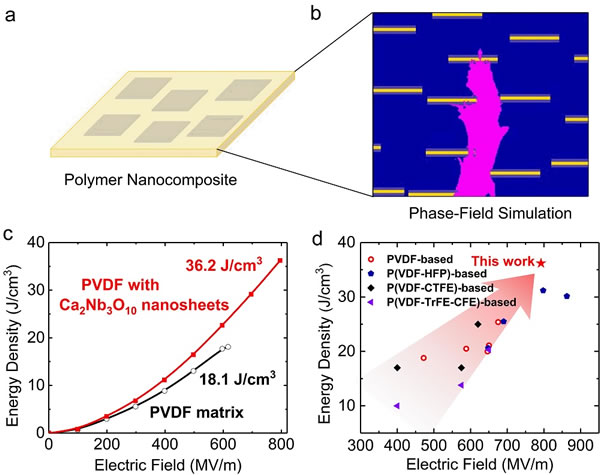The Li Xiaoguang team of the University of Science and Technology of China and the Shenyang research group of Tsinghua University professors have made new progress in the field of high energy storage density flexible capacitors. Researchers have successfully found a method that can greatly increase the breakdown electric field strength and dielectric energy storage density of polymer matrix composites. This method can be extended to different flexible polymer dielectric materials for the design of high energy storage capacitors in the future Provides a feasible solution. The result was published online in the "Adv. Mater." Magazine with the title of Negatively Charged Nanosheets Significantly Enhance the Energy-Storage Capability of Polymer-Based Nanocomposites.
Due to their ultra-fast charge and discharge rate and ultra-high power density, dielectric capacitors have become the core devices of high-energy weapon systems such as smart grid frequency modulation and electromagnetic guns, and have broad application prospects in new energy electric vehicles, wearable electronics and other fields. Among them, flexible polymers with low cost, easy processing, and high voltage resistance are one of the most promising capacitor dielectric materials, but the low energy storage density caused by their low dielectric constant limits the miniaturization and high performance of devices in the electronics industry today. Requirements. In response to this problem, it has been proposed to add high dielectric constant inorganic fillers to the polymer matrix for the preparation of high energy storage density composite materials, but usually the addition of high volume fraction of inorganic materials will reduce the strength of the composite material breakdown electric field , Affecting the safety and longevity of use. Therefore, further increasing the dielectric breakdown field strength while increasing the dielectric constant is a difficult problem to be solved in order to obtain a composite material with high energy storage density.
In response to the above challenges, the cooperative team proposed a universal and feasible strategy, that is, the use of a negatively charged inorganic filler localized reverse electric field to suppress the generation of secondary collision electrons, thereby hindering the formation and development of the breakdown phase, and thus improving the composite material. Field strength and energy storage density. Based on this, the researchers prepared a polyvinylidene fluoride (PVDF) -based composite material mixed with a small amount of negatively charged 2-dimensional Ca2Nb3O10 filler. While increasing its dielectric constant, it obtained extremely high breakdown field strength (~ 792 MV / m) and energy storage density (~ 36.2 J / cm3), the energy storage density of this flexible capacitor is currently the highest reported polymer-based composite material, is currently the best commercial biaxially oriented polypropylene (BOPP ) 18 times that of film capacitors, even exceeding commercial electrochemical capacitors (20-29 J / cm3). In addition, compared to the PVDF matrix, the Young's modulus of the composite material has also been significantly improved while the leakage current density is still maintained at a low level, which is beneficial to avoid the occurrence of electromechanical breakdown and electrothermal breakdown. In order to further verify the universality of the strategy, the researchers verified the important role of the negative charge of the nanosheet filler on the suppression of electrical breakdown based on phase field simulation and finite element calculation, and also achieved it in polystyrene (PS) matrix composites The breakdown field strength and energy storage density have been greatly improved. This research work provides a new idea for the practical application of high energy density flexible dielectric energy storage materials in the future.
Li Xiaoguang and Yin Yuewei, professors of the National Research Center for Microscale Physical Sciences and the School of Physics, Hefei, Chinese University of Science and Technology, and Shen Yang, professor of the School of Materials Science and Technology of Tsinghua University, are the corresponding authors of the paper. Chinese University of Science and Technology PhD students Bao Zhiwei, Hou Chuangming and Tsinghua University PhD student Shen Zhonghui are co-first authors.
The research was supported by the National Natural Science Foundation of China, the National Key R & D Program of the Ministry of Science and Technology, and the "Double First Class" Talent Team Platform Project of the Chinese University of Science and Technology.

Legend: a. Schematic diagram of composite materials. b. In the phase field simulation of the electrical breakdown process of the composite material, the negatively charged Ca2Nb3O10 nanosheets hindered the development of the electrical tree. c. The relationship between the energy storage density of the PVDF-based composite material and pure PVDF and the electric field. d. Comparison of breakdown strength and energy density of different polymer-based nanocomposites.
Copper nuts made of all kinds of embossed wire (usually lead brass, such as H59, 3604, 3602). Our daily contact with the embedded knurled copper nuts are processed by precision automatic lathes. The reference standard of embedded knurled copper nut comes from GB/T809, but the technical parameters of all kinds of embedded nuts produced by our company exceed the relevant indexes required by the national standard.
Knurling copper nut is mainly used for hardware Spring, shaped spring, craft gift spring, battery spring, spring antenna,key ring, phosphorus copper spring CNC automatic lathe turning parts (copper car parts, iron, aluminum car parts), metal stamping parts, electronic parts, iron shaft, single Rachel,Rachel, iron pin, non-standard Screw nut,fittings,fasteners, wire forming (wire card holder, Model aircraft landing gear, S hook, R latch, triangle buckle, D buckle) and other hardware products, belonging to the copper nut series.
Brass Nut,insert nut,knurled nut,injection nut,hex nut
Shenzhen Lanejoy Technology Co.,LTD , https://www.szcoolingrack.com